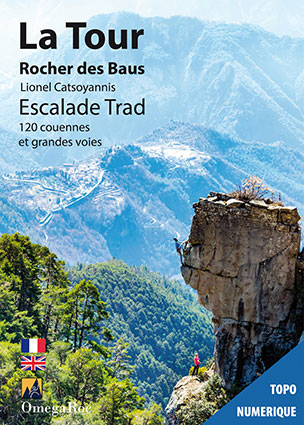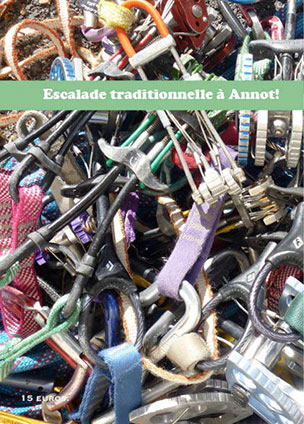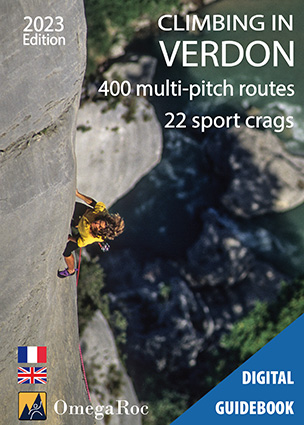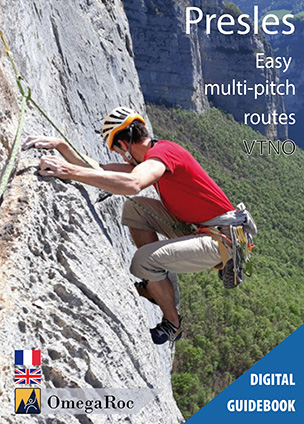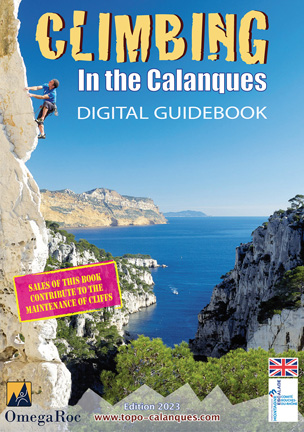
Annot, La Tour, Chasse… the sandstone trad climbing sites around in the Nice area
The sandstone cliffs of the Haut-Verdon and the Nice hinterland are an invaluable gift for trad climbing enthusiasts.
Annot, recognized for several years as THE site for this activity, is no longer alone. The La Tour cliff, located 20 km in a straight line, has no reason to envy. Although discovered 8 years ago, it is only now (2024) that the site shows its potential thanks to the release of a comprehensive guidebook. Other cliffs are currently being developed or in the planning stages… Happy days are ahead of us!
This internet page is dedicated to trad climbing; hence bouldering is not covered here. But since we’re nice guys, we’ll still tell you that the bouldering guidebook for Annot can be found HERE (in french only). But it seems it’s a bit outdated.
The digital guidebook La Tour – Rocher des Baus
See the digital guide on the OmegaRoc app
At the sandstone cliff of La Tour, climbing is exclusively trad (placing your own protections), with only the belay stations in-situ. Most routes are at grade 5c to 7a, hence the site is more accessible in terms of difficulty and technical demands compared to Annot, particularly in terms of pure crack climbing and the rock is generally better and more sculpted.
The La Tour – Rocher des Baus guidebook is a comprehensive guide to the cliff. It already consists of more than a hundred routes (a size comparable to Annot), but La Tour, with its numerous sectors, still holds significant potential.
Each sector is presented with clear and precise route illustrations on photos. For each route, the required gear is specified.
This guidebook is produced by Lionel Catsoyannis, the discoverer (along with Laurent Baghioni) and primary developer of the cliff.
The profits from the sale of this guidebook are entirely reinvested into the maintenance and development of the climbing site.
Annot and Contes, the other guidebooks
Annot
The guidebook Escalade traditionnelle à Annot (2012) currently exists only in paper format and remains the reference guide for the most well-known traditional climbing cliff in France. A bilingual English/French updated digital version is expected in autumn 2024.
The paper guidebook is available for purchase in cafes in Annot and in the Vieux Campeur shops.
Contes – Plantier site (bolted routes)
This sandstone site was created at the request of the municipality of Contes. The routes are quite short and often chipped. The bolts are fairly close, making it a very popular for climbing courses. Harder routes up to 7c are also available. The guidebook is available online HERE (only in french).
La Chasse, the futur
The La Chasse cliff is still relatively unknown but is currently being developed. The rock is extremely hard and does not require much cleaning. But this astonishing vein of sandstone at the source of the Verdon river, located in a paradisial and isolated valley at high altitude, has restricted access periods.
Guidebook coming soon
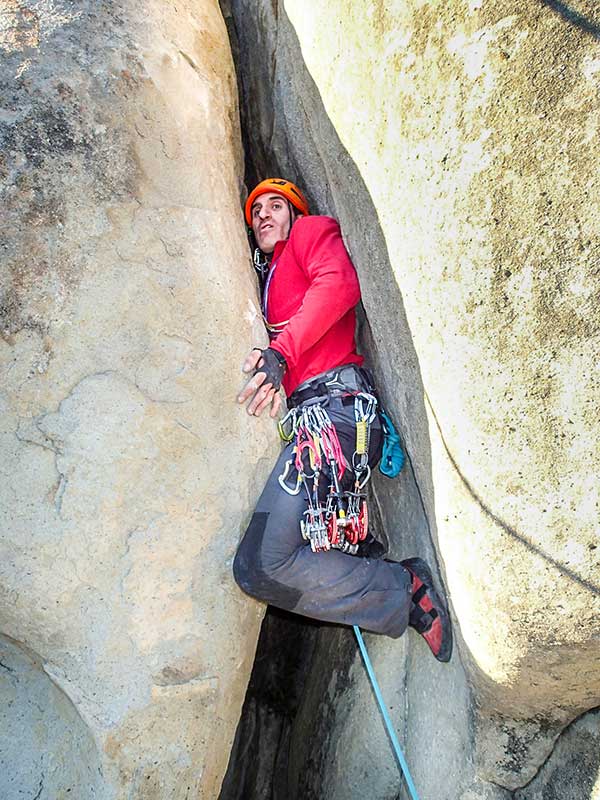
Climbing on sandstone cliffs
When we talk about trad climbing on sandstone, the reference, and therefore the automatic comparison, is on the other side of the Atlantic, at Indian Creek in Utah. This comparison may not mean much to those who have never laid hands on the perfect cracks of this extraordinary site. However, there are so many videos and other documents on the internet that a little curiosity (some might call it general knowledge) will quickly bring you up to date.
So let’s compare:
In simplified terms, the routes at Indian Creek ascend pure cracks with very few holds on the rock faces. Jamming (and sometimes lay-backs) are the foundation and essence of climbing there.
At La Tour and Annot, the cracks are often less “knife-edged”, which may be a bit less photogenic, but it offers more diverse and less monotonous climbing! There are also pockets that allow you, in some places, to break away from the cracks and venture onto the rock faces. With a little imagination and courage, exceptional routes emerge, such as Le Voyage (see the film at the bottom of the page). While this route is reserved for an elite, equally beautiful routes exist at more accessible grades like Spitalgie, Sadomasochiste, Crème Anglaise, Miss Annot, and more.
In summary, the sandstone sites of the Nice hinterland offer trad climbing of exceptional variety in terms of difficulty, style, and commitment. While many routes resemble the American classics, some bold lines evoke more the british ‘’hard-grit’’.
Required gear
For many routes, a standard rack is sufficient by doubling up some sizes. But as soon as you want access all the routes, you need everything: nuts, slings, and of course, cams ranging from micro-micro to super 6. This is what every self-respecting trad climber owns. It’s even an opportunity to dust off your Excentrics and Tricams! The problem is that many routes require multiple cams of the same size. If you’re not made of money, the best solution (and the funniest) is to climb with a group and share gear… Too bad for those without friends, you’ll need more friends!
When venturing far from cracks, it’s often the holes that allow for protection. And there, Totem Cams are formidable.
Note: Of course, you can also use knotted cords and ropes as protection (instructions available in Czech only), but pitons are prohibited.
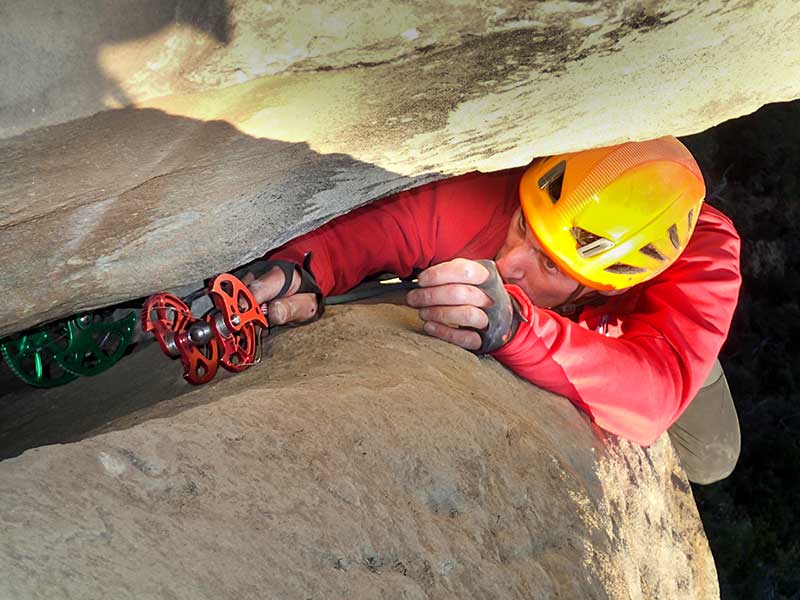
A bit of history… and prehistory.
The cliffs of Annot, La Tour, La Chasse, and finally Comtes are isolated residues of the same geological stratum. This stratum was formed 35 million years ago at the bottom of the sea through the cementation of sediments, primarily sand, before being uplifted during the formation of the Alps and the disappearance of the Alpine sea around 30 million years ago.
A few years passed, and the climbers arrived.
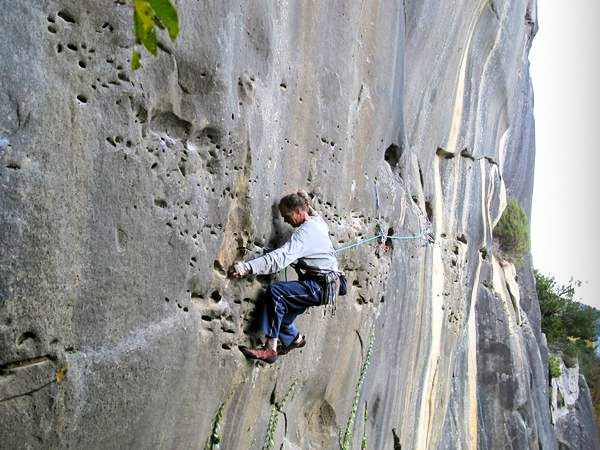
Annot resists
Far from being the obvious choice we know today, the idea of climbing trad at Annot was initially quite problematic. In a country of bolters, the idea that cracks, although obvious and suitable for removable protection, were left free for bolts but instead kept in their natural state, was considered unorthodox —an elitist attitude that would deprive most climbers from enjoying these beautiful lines.
Antoine Barbier, Lionel Catsoyannis, and their friends (Paola Pezzini, Marc Gamio, Florent Baghioni, Marie-line Madelaine…) nonetheless began opening and cleaning routes to climb them in a traditional style.
Some thought it appropriate to equip with bolts… which our trad climbers systematically removed while trying to convey the significance of trad climbing. But it was probably too early, and our trad climbers were labeled as elitist and narrow-minded.
Over the years, common sense prevailed and Annot has become a dominant hub for traditional climbing in Europe. Attendance has skyrocketed, legitimizing this approach to climbing, and some of the initial opponents now come to Annot to introduce groups to the joys of trad climbing!
The Charms of La Tour
In search of novelty, some of the veterans from Annot cast their eyes on the vein of sandstone at Rocher de Baus in La Tour-sur-Tinée to “scratch” a few lines. Initially, Lionel and Florent did not grasp the potential of the cliff. It gradually took shape over the course of openings to become a site of the highest order. Collaboration with the municipality is exemplary, and La Tour is now one of the few sites for trad climbing in the process of being formalized and included in a Departmental Plan for Spaces, Sites, and trails (PDESI), which embodies cooperation among stakeholders in sports, environmental, and tourism.
Thanks to this guidebook, Le Rocher des Baus will now be accessible to all and continue its development.
In the series “The Empire of Trad Strikes Back,” more episodes are coming. After “Annot Resists” and “The Charms of La Tour,” the next one will not be long in coming: “Who’s Gonna Hunt for Class at La Chasse.“
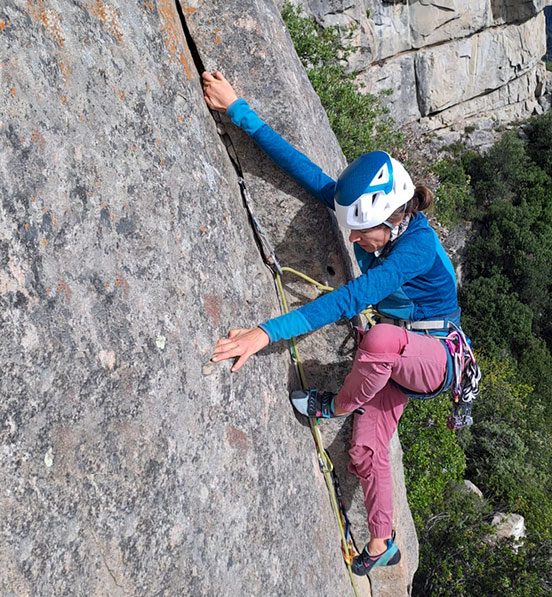
Worskhops – Introduction to Trad Climbing / advanced course
I’ve been organizing trad climbing workshops for over 10 years.
Whether you’re looking to discover trad climbing or improve your skills with gear and crack technique.
Previously held in Verdon or Annot, these workshops will now take place at La Tour – Rocher des Baus, a perfectly suited site for this type of training.
2/3-day workshop – Accommodation available on-site.
Language: french, english, italian
We can also climb the route of your dreams together.
Contact: Lionel Catsoyannis +33 6 61 44 50 54
It happened at Annot…
Since the La Tour site is new, fresh out of the oven, there are no films of this cliff yet. But that won’t be long.
Originally named “Les voillages faurme la jenaice,” Le Voyage has become THE mythical route in Annot. Many very strong climbers have had their spirits broken here. Here is the first ascent.
Guided tour of Annot with Steve McClure and James Pearson.
Antoine Barbier climb the route “T’as que ces mots” in Annot. The proof that it’s not only about cracks in Annot…
After Le Voyage, Bon Voyage… even harder. It’s a shame there’s no video of James Pearson during the first ascent. We’ll have to settle for Adam Ondra during the second ascent.
Explore the crags in the neighborhood
Here are somme digital guidebooks for climbing in the surroundings areas.
To see all the guidebooks available on the OmegaRoc app: The OmegaRoc guidebooks
Acknowledgments:
Thanks to Sam Bié for allowing us to use their photos to illustrate this internet page.

